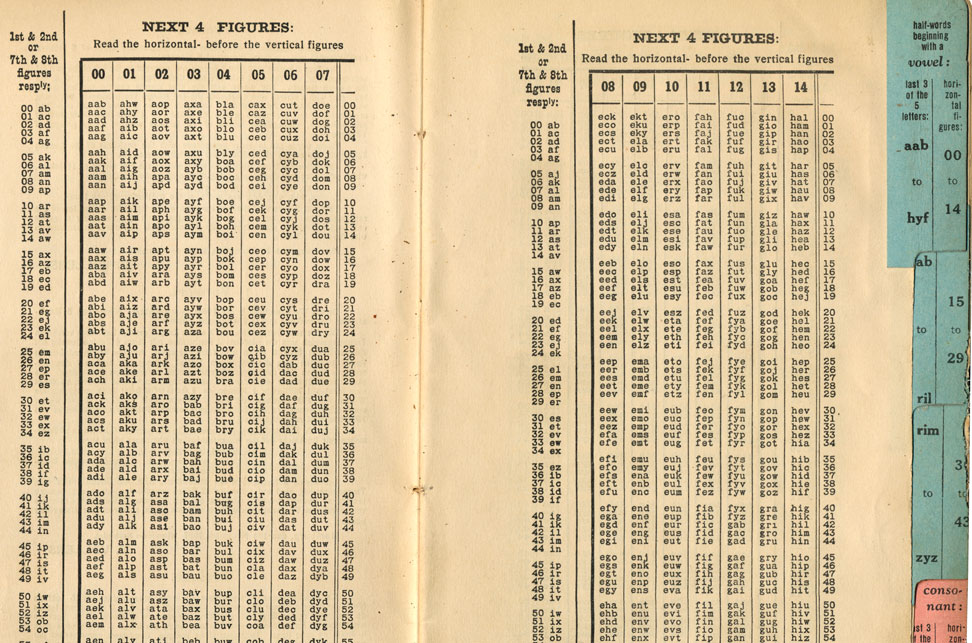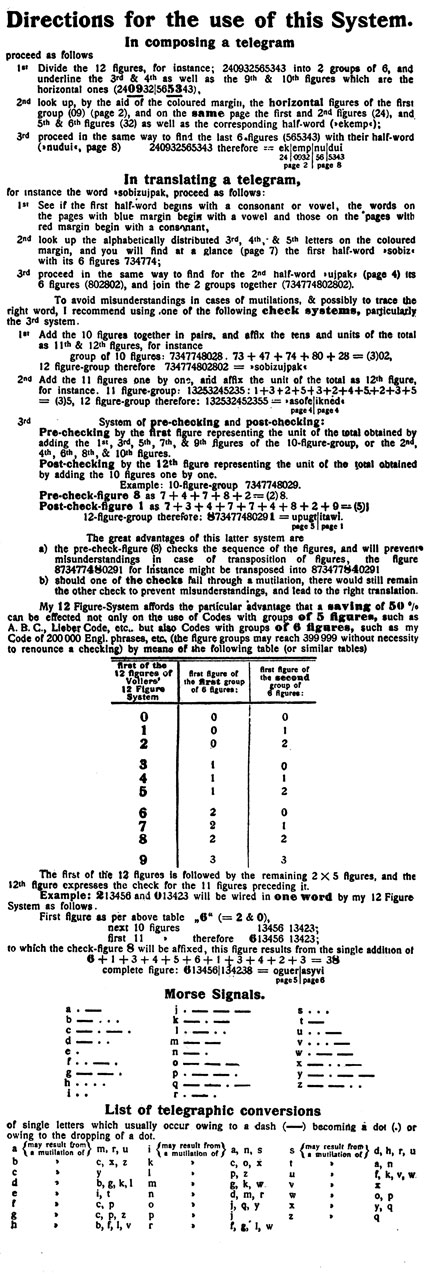
Detail from
Vollers' 12 Figure-System : 1 000 000 000 000 pronounceable words all of 10 letters in strict accordance with the decisions of the London Telegraph Conference of 1903
(Hamburg, 1907, this being reprint of 1906 edition)
5 3/4 x 12 1/4 inches; 20pp
Condensers were used to generate pronounceable, rugged and checkable five- and 10-letter code words for figure sequences assembled from figure codes. It was cheaper to wire words than to wire numbers; moreover, figures were (or were said to be) more vulnerable to mutilation than words.
Finally, figure codes were well suited to complex private codes involving ergodic protocols of message generation and unpacking. The 0-9 and 00-99 possibilities of each position and position-pair were suited to methodical presentation of message molecules — typically located in tables, to which one would turn in ordered sequences. Coding was already trying enough, without worrying at this level about cv vc and dangerous letter-pair issues. The condensers came into play after initial coding into figures was done: these were converted, step by step, into letter pairs and triads in the forms vc or cv, vcv or cvc, cvv or vvc, yielding 5L and 10L codewords.
Condensers could also be used to super-encrypt messages generated by standard 5L and other codes for which figures were provided for each phrase or message molecule.
There was no semantic dimension to the condensers: they were dedicated solely to the generation of unique codewords satisfying Telegraph Administration rules about pronounceability and length. Those artificial words were symbols referring only to a series of figures; they might echo or resemble actual dictionary words, but only accidentally. They are not the stuff of poetry, unless it be of the dada version, which they certainly parallel and even predate. Their euphony in combination with the absence of semantic intentionality together locate them uncertainly in the realm of conlangs (constructed languages).
A single example codeword and figure is placed at the bottom of each page in the Vollers condenser:
| ubamy | 710168 | half-words beginning with a vowel |
| ocego | 540845 | |
| ovife | 631546 | |
| ucoab | 752466 | |
| ontus | 673372 | |
| envor | 283807 | |
| daama | 124536 | half-words beginning with a consonant |
| tedwa | 775365 | |
| puhda | 626163 | |
| nameb | 527276 | |
| horva | 338423 | |
| ryurc | 699060 |
Not all condensers took the form shown above in the Vollers example. Others were simpler lists of letter pairs and triads; one also encounters examples of (and/or patents for) condensers in sliderule, wheel and mechanical forms.
Code condensers relate in some ways to mutilation tables, a topic that will be examined here in due course.
From the Preface —
This book contains 1 million words of 5 letters (half-words) with as many groups of 6 figures.
The first 2 letters and first 2 figures are arranged to the left of the vertical separation line, and the next 3 letters with their 4 figures to the right of it, on the same page. The pages with the blue margin contain the halfwords beginning with a vowel and those with the red margin the half-words beginning with a consonant. As all of these halfwords can be prefixed as well as affixed to each others, this produces 1 million x 1 million = 1 000 000 000 000 of pronounceable, complete words of 10 letters with as many groups of 12 figures.
These words are in strict accordance with the decisions of the London Telegraphy Conference of 1903, and are officially admissible.
The following letter groups do not occur in the full words of 10 letters, which precludes any doubts regarding their easy proncounceability:
- jj, xx, iiy, iyi, iyy, yii, yyi, yiy,
- aaa, bbb, ccc, ddd, eee etc. i.e. the triplication of any letter.
The first 2 letters of the halfwords, i.e., the syllables to the left of the separation line, vary on each of the 12 pages, as it was necessary to select only such syllables as would form easily proncounceable half-words in conjunction with the next 3 letters.
Hamburg, the 1st November, 1907 (date of reprint). R. Vollers.
